|
-
4th June 07, 10:40 AM
#11
Sorry to be joining this thread late; my weekends are "unplugged" from the internet.
Congratulations, JohnH, on your discovery. You described perfectly the frustrations of the "archeological" digging it took to recover the techniques of this pleating style. The Commonwealth militaries appear to be rapidly shrinking their kilted forces, and losing the knowledge base of their kiltmakers. Outside the militaries, it's almost as if the guild system, with its protected trade knowledge, is still at work for the relatively few kiltmakers who can make this pleating style. Thank goodness for reverse engineering and old kilts as examples.
Of course, none of these techniques would make any sense unless built on top of the foundation of kiltmaking as taught bt Elsie and documented by Barb.
 Originally Posted by JohnH

** Hmmm….. the regiment was formed in early 1961, by amalgamating the Seaforth Highlanders with the Queen’s Own Cameron Highlanders and Elsie apprenticed with Thomas Gordon...
In my conversations with Elsie, she told me she must have learned this style as a young lass, but hadn't made one for many decades and couldn't remember the differences. Soon after this time I had worked out everything but the pleat basting. How she managed to remember it I don't know, but in a later telephone call she described the basting step with the clarity necessary to penetrate my thick skull. Your pic of the ex-MOD kilt shows well the pleat basting.
Again, congratulations - and welcome to the ranks of the hopelessly addicted.
w2f
"Listen Men.... You are no longer bound down to the unmanly dress of the Lowlander." 1782 Repeal.
* * * * *
Lady From Hell vs Neighbor From Hell @ [url]http://way2noisy.blogspot.com[/url]
-
-
4th June 07, 11:09 AM
#12
 Originally Posted by Sean_the_Kilted

I've seen the diagrams of what makes a Military box pleat, but what makes it so special? They seem like they would be a lot heavier.
In reality they are no heavier than a traditional knife pleated kilt; the pleat depths are shallower and the pleats more intricate, but they are still pleated to the stripe and one pleat per sett. What makes them so special, IMHO, is the way the pleats swing (or, shall I say, they swing both ways  ). Even though the knife-pleated kilt is an asymmetric garment, the small box on top of the pleat gives it a much more symmetrical appearance during low activity. In the regiments, a band of elastic is tacked in the inside loosely across the pleats, probably to help keep the intricate pleats from unfolding too much and not refolding correctly. ). Even though the knife-pleated kilt is an asymmetric garment, the small box on top of the pleat gives it a much more symmetrical appearance during low activity. In the regiments, a band of elastic is tacked in the inside loosely across the pleats, probably to help keep the intricate pleats from unfolding too much and not refolding correctly.
But I did see an ex-MOD Seaforth Highlander in MacKenzie tartan on an athlete at the Livermore Games a couple weeks ago. I believe his was minus the elastic, judging from his twirl during the weight tosses. The kilt is no heavier, just maybe a bit warmer in the pleats because of the layering.
Kathy Lare and others make them, What Price Glory does a reproduction mil-box, and auctions regularly turn up ex-MOD mil-boxes. If you like kilts (is that an oxymoron on this forum?), you'll love military box pleats. 
w2f
"Listen Men.... You are no longer bound down to the unmanly dress of the Lowlander." 1782 Repeal.
* * * * *
Lady From Hell vs Neighbor From Hell @ [url]http://way2noisy.blogspot.com[/url]
-
-
4th June 07, 09:55 PM
#13
My thanks to way2fractious for his comments. He's quite right, it's not just the kilts. Trying to reproduce the military box pleat has been very time consuming, extremely frustrating and now, very satisfying. It is also quite likely that I will make almost all of my future kilts in this style as it provides an indescribable, but satisfying extra something to kilt wearing.
I wrote up this account as a journal during construction, which is not yet complete. So, you may notice bits that have been covered in other posts.
How I did it. (There are other ways to do this, but this is what worked for me.)
Measure & mark the cloth as normal for pleated to stripe knife pleats. Grab the outside edge of each pleat at the hip, fold the extension (the box bit) back on itself and pin it from top to bottom. (Make sure that the dominant stripe is centred in the folded bit.) Now, adjust the hip to waist portion of the pleat extension and taper it to the waist, keeping the dominant stripe centred and make sure there is no taper in the rise, then baste both edges, about 1/8” from the edge, beginning with the one furthest from you. (Right side up, top to your right. [Top to your left to baste the other edges.]) Baste all of the extensions before beginning to sew.

View from bottom. Pleats are stitched at X, edge to edge.
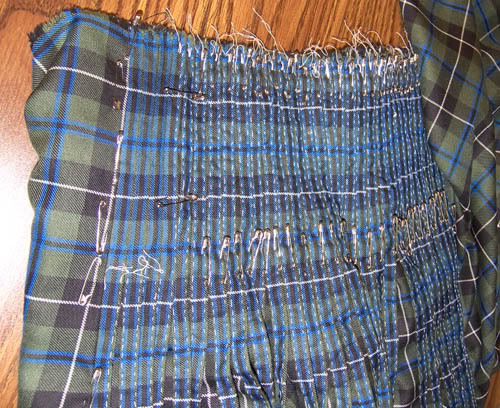
All pleat extensions basted. I removed the fell basting after sewing them down. The rest of it will come out after pressing & finishing.
When you have basted all of the box extensions, sew the edge closest to you of the first box extension to ONLY the first layer underneath it. (Right side up, top to the left.) (NB the visible edge of the deep pleat at the right of the apron is NOT folded over. [Must be a part of that elusive Specification!]) Then sew each pleat extension with a catch stitch* to its’ neighbour. (I suggest that you practice first with some scrap fabric as it takes time to figure out how things are going to behave and you don’t want to damage good fabric by repeatedly ripping out stitches. [Please don’t look too closely at my first pleat!]) Right edge to the next left edge. (When viewed with the top at the top,)
(* I assume that this is the stitch to use here as it is the only one that I found would do the job. I welcome any input from the experts on this point.)
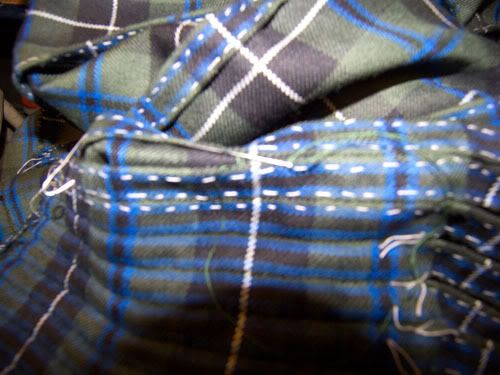
Sorry, my camera seems to have a problem with macro auto-focus.
Open the seam a little to give yourself room to work. Use some backstitch, this way, that way, as necessary, to keep the horizontal stripes lined up.) from hip to top and MAKE SURE THAT YOU ONLY CATCH ONE LAYER! Repeat. Repeat. Repeat. Once you have joined the last pleat to the under-apron, proceed as for a pleated to stripe kilt.* The start and finish of the project are no different to a normal knife pleat kilt. It’s just the way the pleats are formed and stitched.
*I have been re-reading some older threads and I found in one,
(http://www.xmarksthescot.com/forum/s...ad.php?t=16994),
that way2fractious had had a go at the same thing and had noticed that there was just one stitched layer at the back. Since I did, partially, reverse-engineer a military kilt, I can confirm that this is so. What they did with mine was to taper the cuts over a longer length, but that the remaining bits are only about ˝” wide at the bottom of the canvas and probably the rest of the way to the top. With 18oz. material, strength may not be an issue, but with the lighter materials it might be better to leave larger pieces. Also, the canvas in mine is not as tall as Barb recommends, so following her suggestions here on how to taper the cut and size of the canvas would add strength.
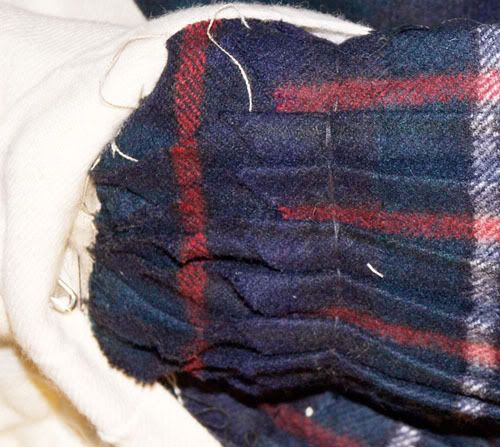
Close-up of pleat cuts in my QOH kilt. After the initial sharp cut the taper is gradual down to about ˝” at the bottom of the canvas. Also, the steeking is doubled up.
An odd thing, but it makes life easier should you later find that one of the horizontal stripes is not aligned properly, (Mea culpa!) is that you only have to rip out one row of stitches to correct the problem, unlike a knife pleat job where you have to rip all the way back to the offending pleat.
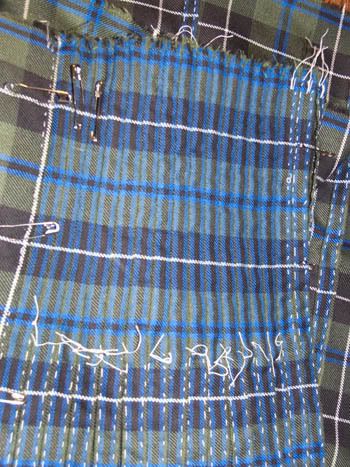 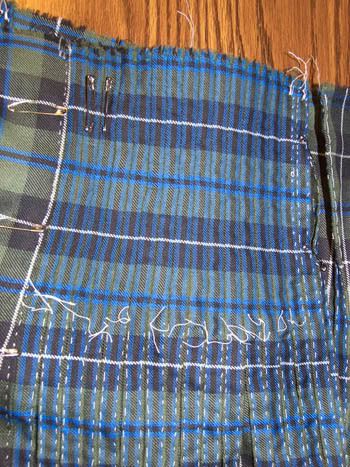
Look at the left edges of pleats 5 & 6. Pic on the right is after I redid them. (The 2 safety pins, (Quilter’s pins, which are curved and much easier to use,) are keeping the buttonhole closed. The pins to the left are keeping the deep pleat aligned at the back.)
The reinforcement strip, canvas & steeking are absolutely necessary as the pleats are NOT sewn through 4 layers. (If they were, you could not cut away enough excess fabric & the top of the kilt would be too bulky. You have 2 extra layers here! But, when you have finished, there is no difference to a knife pleat kilt.)
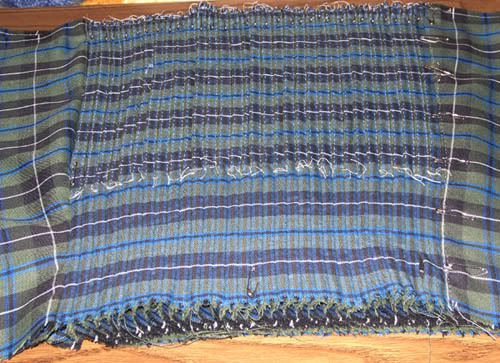
Pleats all stitched. (The horizontals are straight. It needs cutting the excess and pressing to show that. The pin marks the centre-back.)
The illustration below shows the view of both types of pleating when viewed from the top by holding the kilt right side to the top and letting the pleats swing free. The stitches on the knife pleat version go through 4 layers, but the military box version only stitches one layer.
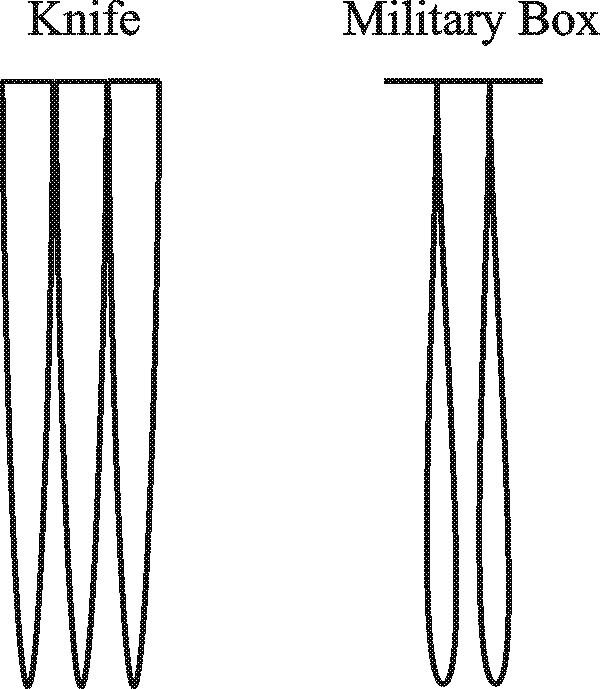

When I started to baste the pleats, I found that the bottom of the folded bit was curling up so, I removed the basting from the left edge and replaced it with a baste through all 3 layers along the edge. (As done by way2fractious.) This will take time, but it will be a lot easier next time.
-
-
4th June 07, 10:33 PM
#14
Perhaps you and w2f might collaborate on a manual? *hint, hint*
think of it as an addendum to the Art of Kiltmaking. 10-13 pages plus a dozen photographs should do it.
-
-
5th June 07, 09:29 AM
#15
 Originally Posted by Alan H

Perhaps you and w2f might collaborate on a manual? *hint, hint*
think of it as an addendum to the Art of Kiltmaking. 10-13 pages plus a dozen photographs should do it.
Why am I not surprised that Alan H suggests someone else write another manual? 
JohnH, I read through your info above - and found myself tripping down memory lane. The pics of pleats basted into place with two vertical basting lines, and several other lines too, made my fingers itch. Those pics match some that I posted a long while back.
The good news is: What you and I posted were still learning exercises. When I covered some of these steps with Elsie, and showed her my practice pieces, she steered me back into steps that more closely align with those of the traditional knife-pleat. The practice pieces allowed you and me to explore and confirm the mechanics, but the actual process is really much easier.
Back to Alan's nudging, I made one aborted attempt to re-write certain paragraphs on certain pages of The Art of Kiltmaking. I abandoned it because in truth it would have been an act of plagiarism against Barb T, whom I had not consulted regarding such a thing. Perhaps it still could be done, with her permission and/or involvement. I will be seeing her in a couple weeks in Victoria, BC at the 2007 Kilt Kamp. (Another item for that weekend's agenda.  ) )
Last edited by way2fractious; 19th June 07 at 02:21 PM.
"Listen Men.... You are no longer bound down to the unmanly dress of the Lowlander." 1782 Repeal.
* * * * *
Lady From Hell vs Neighbor From Hell @ [url]http://way2noisy.blogspot.com[/url]
-
-
5th June 07, 03:10 PM
#16
In the regiments, a band of elastic is tacked in the inside loosely across the pleats, probably to help keep the intricate pleats from unfolding too much and not refolding correctly. (w2f)
Just like this:
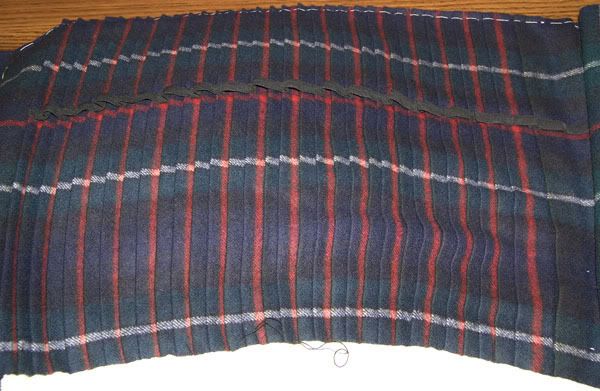
Elastic is sewn to alternate pleats. It is 5 1/2" up from the bottom. My knife pleat ex Black Watch does not have this, so it would appear to only be used on the box pleat kilts. My very first kilt was ex-Seaforth and it had the elastic.
The good news is: What you and I posted were still learning exercises. (w2f)
I hear you loud and clear. My Douglas currently has bastings running every which-way! But, it's the best way to learn. This leads me to have some sympathy for Alan H's request for a manual, as I do believe that this technique should not be allowd to die out. Speaking of which, The new Royal Regiment of Scotland’s kilts will be made in Scotland with fabric woven by Robert Noble, although it will be 16 oz. and they will be machine-stitched (Hmmm....will this quest never end?) box pleats, using a version of the Argyle tartan with a lightened green. (Basically, Black Watch. Does this make it Pattern 1B?)
[The 64 hand sewn prototypes that were made by Argyle Bagpipes were recently offered for sale on eBay.co.uk. I did not buy one because they are current issue, but, it was very tempting. {It’s an honour thing. I do wear my Naval dress sword belt (minus the frog) with my kilts even though it is still current issue, but I did serve in the RN, as did both of my parents. I never did and never will serve in the RRS.}] The expired auction can be seen at:
http://cgi.ebay.ca/ws/eBayISAPI.dll?...3216&rd=1&rd=1
Note these kilts may be relisted later as none appear to have been sold.
I will be seeing her in a couple weeks in Victoria, BC at the 2007 Kilt Kamp.
(w2f)
I was originally going to be there, but my work has an annoying habit of interfering with my leisure time and I had to cancel.
-
-
6th June 07, 04:18 PM
#17
I read through all the posts three times before the penny dropped as to what this is.
It is a box pleat, not the three layer 'simple' nor the five layers of the same size version - it is, as I count them, a variant of the five layer with three layers the same size and the inner two layers extended to cover two pleats.
Sort of a box pleat and knife pleat combined.
I can 'see' it now - but the thing would be to make one.
Just to be sure that I have it clear, for the standard male pattern, the longer back fold - that is the same orientation as the single pleat of a knife pleated kilt, and would point towards the back on the left and the front on the right?
I wonder if I can adapt it to a Kinguisse style and not go mad in the process? No need to answer that, I think I lost the plot some time ago.
I do have some not really a tartan fabric, which has a nice stripe in it though - I must have a go just to see if I can do it.
Reducing in size would require the inner workings to be removed and the individual pleats in the fell made narrower - I think I might make this kilt several inches too small for me at the moment, by the time I finish it it will probably fit.
Ah the joy of kilt making - just when you think you have really got a handle on it someone adds a whole extra dimension.
-
-
6th June 07, 04:38 PM
#18
Sort of a box pleat and knife pleat combined.
It's probably closer to a knife. If you lay out a kilt for knife pleats and then fold the reveal part of the knife back on itself, you end up with the military box pleat. Of course, the stitching is completely different.
Just to be sure that I have it clear, for the standard male pattern, the longer back fold - that is the same orientation as the single pleat of a knife pleated kilt, and would point towards the back on the left and the front on the right?
Yes, the back part of the pleat is standard knife and the front (visible) part points the other way.
I wonder if I can adapt it to a Kinguisse style and not go mad in the process? No need to answer that, I think I lost the plot some time ago.
If that doesn't drive you mad, consider (like me!) the possibility of doing this to the sett!
Ah the joy of kilt making - just when you think you have really got a handle on it someone adds a whole extra dimension.
But without the continual challenges, life would be boring.
-
-
6th June 07, 05:34 PM
#19
 Originally Posted by JohnH

If that doesn't drive you mad, consider (like me!) the possibility of doing this to the sett!
After making my 16 oz Weathered MacLaren military box pleat kilt - and just for kicks! - I took the remaining portion of the ripped center strip and basted it up in mil-boxes pleated to the sett. Just as in a regular knife pleated kilt, the pleats are slightly deeper because of the added "next element" of the sett. If you get the tapers marked and stitched right, the pleats are no problem to baste. (Hmmm... I think that practice piece is still kicking around here somewhere...)
 Originally Posted by Pleater
It is a box pleat, not the three layer 'simple' nor the five layers of the same size version - it is, as I count them, a variant of the five layer with three layers the same size and the inner two layers extended to cover two pleats.
Sort of a box pleat and knife pleat combined.
I can 'see' it now - but the thing would be to make one.
...
I wonder if I can adapt it to a Kinguisse style and not go mad in the process? No need to answer that, I think I lost the plot some time ago.
Yes, this is not the simple three-layer box pleat. As JohnH pointed out, from the outside it is simply a knife-pleated kilt, but approximately one inch of each knife edge of each pleat is folded back the other direction. Usually that folded back inch "reveals" the stripe, the same stripe in the stitched tapers above the fell line.
Adapt it to the Kinguisse style pleating? I hadn't thought about it, but I'm guessing that if you get the tapers marked and stitched right, and allow for the center back box pleat, then the other pleats should be no problem to baste. I have not made a Kinguisse-style kilt from wool tartan before, so I may have to try one someday, but I cannot visualize military boxes adding anything particularly striking to its presentation.
"Listen Men.... You are no longer bound down to the unmanly dress of the Lowlander." 1782 Repeal.
* * * * *
Lady From Hell vs Neighbor From Hell @ [url]http://way2noisy.blogspot.com[/url]
-
-
6th June 07, 08:35 PM
#20
I just want to say thank you to John and others who have contributed to this thread. I'm going to have to absorb this for a while, but if I can figure it out, I'm making one! 
It don't mean a thing, if you aint got that swing!!
'S Rioghal Mo Dhream - a child of the mist
-
Similar Threads
-
By wsk in forum The Tartan Place
Replies: 23
Last Post: 2nd December 06, 08:32 PM
-
By Richland in forum How to Accessorize your Kilt
Replies: 36
Last Post: 17th May 06, 08:51 PM
-
By way2fractious in forum Professional Kiltmakers Hints and Tips
Replies: 14
Last Post: 6th May 06, 03:49 PM
-
By mcnice in forum Kilt Advice
Replies: 4
Last Post: 16th October 04, 02:30 AM
-
By Raphael in forum Contemporary Kilt Wear
Replies: 6
Last Post: 15th May 04, 05:55 PM
Tags for this Thread
 Posting Permissions
Posting Permissions
- You may not post new threads
- You may not post replies
- You may not post attachments
- You may not edit your posts
-
Forum Rules
|
|































Bookmarks